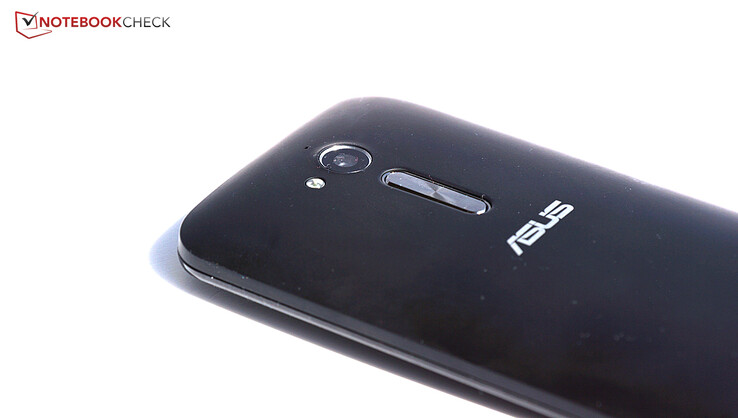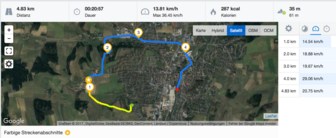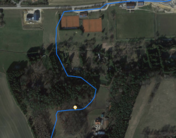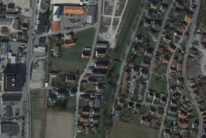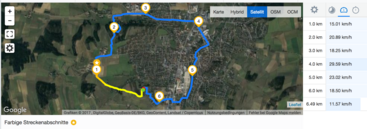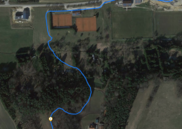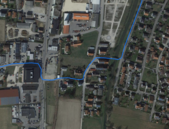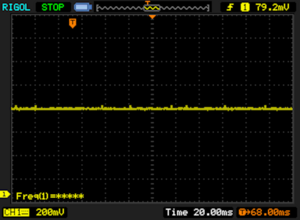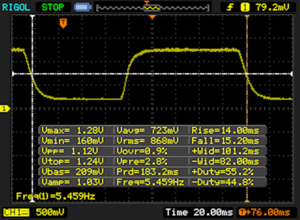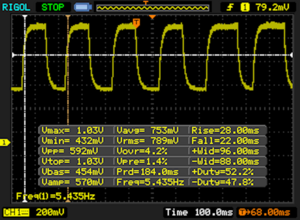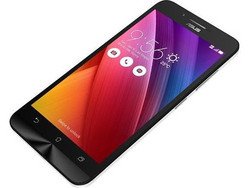Breve análisis del smartphone Asus ZenFone Go
Top 10 Análisis
» Top 10 Portátiles Multimedia
» Top 10 Portátiles de Juego
» Top 10 Portátiles de Juego ligeros
» Top 10 Portátiles Asequibles de Oficina/Empresa
» Top 10 Portátiles de Juego Ligeros
» Top 10 Portátiles de Oficina/Empresa Premium
» Top 10 Estaciones de Trabajo
» Top 10 Subportátiles
» Top 10 Ultrabooks
» Top 10 Convertibles
» Top 10 Tablets
» Top 10 Tablets Windows
» Top 10 Tablets de menos de 250 Euros
» Top 10 Phablets (>5.5")
» Top 10 Smartphones
» Top 10 Smartphones (≤5")
» Top 10 Smartphones de menos de 300 Euros
» Top 10 Smartphones de menos de 120 Euros
» Top 10 Portátiles de menos de 1000 Euros
» Top 10 Portátiles de menos de 500 Euros
» Top 10 Portátiles de menos de 300 Euros
» Los Mejores Displays de Portátiles Analizados por Notebookcheck
| Networking | |
| iperf3 transmit AX12 | |
| Asus Zenfone Go ZB500KL | |
| Huawei P8 lite 2017 | |
| LG X Power K220 | |
| Lenovo K6 | |
| iperf3 receive AX12 | |
| Asus Zenfone Go ZB500KL | |
| Huawei P8 lite 2017 | |
| Lenovo K6 | |
| LG X Power K220 | |
| |||||||||||||||||||||||||
iluminación: 84 %
Contraste: 1093:1 (Negro: 0.42 cd/m²)
ΔE ColorChecker Calman: 4.5 | ∀{0.5-29.43 Ø4.78}
ΔE Greyscale Calman: 6.5 | ∀{0.09-98 Ø5}
96.23% sRGB (Calman 2D)
Gamma: 2.22
CCT: 7791 K
| Asus Zenfone Go ZB500KL IPS, 1280x720, 5" | LG X Power K220 IPS, 1280x720, 5.3" | Wiko U Feel IPS, 1280x720, 5" | Lenovo K6 IPS, 1920x1080, 5" | Huawei P8 lite 2017 IPS, 1920x1080, 5.2" | |
|---|---|---|---|---|---|
| Screen | -11% | 14% | 5% | 9% | |
| Brightness middle (cd/m²) | 459 | 381 -17% | 500 9% | 470 2% | 575 25% |
| Brightness (cd/m²) | 452 | 352 -22% | 485 7% | 461 2% | 559 24% |
| Brightness Distribution (%) | 84 | 85 1% | 83 -1% | 88 5% | 91 8% |
| Black Level * (cd/m²) | 0.42 | 0.2 52% | 0.22 48% | 0.38 10% | 0.39 7% |
| Contrast (:1) | 1093 | 1905 74% | 2273 108% | 1237 13% | 1474 35% |
| Colorchecker dE 2000 * | 4.5 | 7.3 -62% | 6.3 -40% | 5.2 -16% | 5.2 -16% |
| Colorchecker dE 2000 max. * | 10.6 | 21.2 -100% | 14.4 -36% | 9.5 10% | 10.3 3% |
| Greyscale dE 2000 * | 6.5 | 7.4 -14% | 5.2 20% | 5.6 14% | 7.2 -11% |
| Gamma | 2.22 99% | 2.26 97% | 2.17 101% | 2.24 98% | 2.4 92% |
| CCT | 7791 83% | 8417 77% | 7536 86% | 7924 82% | 7224 90% |
* ... más pequeño es mejor
Parpadeo de Pantalla / PWM (Pulse-Width Modulation)
| Parpadeo de Pantalla / PWM no detectado | |||
Comparación: 53 % de todos los dispositivos testados no usaron PWM para atenuar el display. Si se usó, medimos una media de 8111 (mínimo: 5 - máxmo: 343500) Hz. | |||
Tiempos de respuesta del display
| ↔ Tiempo de respuesta de Negro a Blanco | ||
|---|---|---|
| 29 ms ... subida ↗ y bajada ↘ combinada | ↗ 14 ms subida | |
| ↘ 15 ms bajada | ||
| La pantalla mostró tiempos de respuesta relativamente lentos en nuestros tests pero podría ser demasiado lenta para los jugones. En comparación, todos los dispositivos de prueba van de ##min### (mínimo) a 240 (máximo) ms. » 76 % de todos los dispositivos son mejores. Eso quiere decir que el tiempo de respuesta es peor que la media (20.2 ms) de todos los dispositivos testados. | ||
| ↔ Tiempo de respuesta 50% Gris a 80% Gris | ||
| 50 ms ... subida ↗ y bajada ↘ combinada | ↗ 28 ms subida | |
| ↘ 22 ms bajada | ||
| La pantalla mostró tiempos de respuesta lentos en nuestros tests y podría ser demasiado lenta para los jugones. En comparación, todos los dispositivos de prueba van de ##min### (mínimo) a 636 (máximo) ms. » 85 % de todos los dispositivos son mejores. Eso quiere decir que el tiempo de respuesta es peor que la media (31.6 ms) de todos los dispositivos testados. | ||
| AnTuTu v6 - Total Score (ordenar por valor) | |
| Asus Zenfone Go ZB500KL | |
| LG X Power K220 | |
| Wiko U Feel | |
| Lenovo K6 | |
| Huawei P8 lite 2017 | |
| Geekbench 4.0 | |
| 64 Bit Single-Core Score (ordenar por valor) | |
| Asus Zenfone Go ZB500KL | |
| LG X Power K220 | |
| Lenovo K6 | |
| Huawei P8 lite 2017 | |
| 64 Bit Multi-Core Score (ordenar por valor) | |
| Asus Zenfone Go ZB500KL | |
| LG X Power K220 | |
| Lenovo K6 | |
| Huawei P8 lite 2017 | |
| 3DMark | |
| 1280x720 offscreen Ice Storm Unlimited Score (ordenar por valor) | |
| Asus Zenfone Go ZB500KL | |
| LG X Power K220 | |
| Wiko U Feel | |
| Lenovo K6 | |
| Huawei P8 lite 2017 | |
| 1280x720 offscreen Ice Storm Unlimited Graphics Score (ordenar por valor) | |
| Asus Zenfone Go ZB500KL | |
| LG X Power K220 | |
| Wiko U Feel | |
| Lenovo K6 | |
| Huawei P8 lite 2017 | |
| 1280x720 offscreen Ice Storm Unlimited Physics (ordenar por valor) | |
| Asus Zenfone Go ZB500KL | |
| LG X Power K220 | |
| Wiko U Feel | |
| Lenovo K6 | |
| Huawei P8 lite 2017 | |
| 2560x1440 Sling Shot OpenGL ES 3.0 (ordenar por valor) | |
| Asus Zenfone Go ZB500KL | |
| LG X Power K220 | |
| Wiko U Feel | |
| Lenovo K6 | |
| Huawei P8 lite 2017 | |
| 2560x1440 Sling Shot OpenGL ES 3.0 Graphics (ordenar por valor) | |
| Asus Zenfone Go ZB500KL | |
| LG X Power K220 | |
| Wiko U Feel | |
| Lenovo K6 | |
| Huawei P8 lite 2017 | |
| 2560x1440 Sling Shot OpenGL ES 3.0 Physics (ordenar por valor) | |
| Asus Zenfone Go ZB500KL | |
| LG X Power K220 | |
| Wiko U Feel | |
| Lenovo K6 | |
| Huawei P8 lite 2017 | |
| GFXBench (DX / GLBenchmark) 2.7 | |
| T-Rex Onscreen (ordenar por valor) | |
| Asus Zenfone Go ZB500KL | |
| LG X Power K220 | |
| Wiko U Feel | |
| Lenovo K6 | |
| Huawei P8 lite 2017 | |
| 1920x1080 T-Rex Offscreen (ordenar por valor) | |
| Asus Zenfone Go ZB500KL | |
| LG X Power K220 | |
| Wiko U Feel | |
| Lenovo K6 | |
| Huawei P8 lite 2017 | |
| GFXBench 3.0 | |
| on screen Manhattan Onscreen OGL (ordenar por valor) | |
| Asus Zenfone Go ZB500KL | |
| LG X Power K220 | |
| Wiko U Feel | |
| Lenovo K6 | |
| Huawei P8 lite 2017 | |
| 1920x1080 1080p Manhattan Offscreen (ordenar por valor) | |
| Asus Zenfone Go ZB500KL | |
| LG X Power K220 | |
| Wiko U Feel | |
| Lenovo K6 | |
| Huawei P8 lite 2017 | |
| PCMark for Android - Work performance score (ordenar por valor) | |
| Asus Zenfone Go ZB500KL | |
| LG X Power K220 | |
| Wiko U Feel | |
| Lenovo K6 | |
| Huawei P8 lite 2017 | |
| Octane V2 - Total Score (ordenar por valor) | |
| Asus Zenfone Go ZB500KL | |
| LG X Power K220 | |
| Wiko U Feel | |
| Lenovo K6 | |
| Huawei P8 lite 2017 | |
| JetStream 1.1 - Total Score (ordenar por valor) | |
| Asus Zenfone Go ZB500KL | |
| LG X Power K220 | |
| Wiko U Feel | |
| Lenovo K6 | |
| Huawei P8 lite 2017 | |
| Mozilla Kraken 1.1 - Total (ordenar por valor) | |
| Asus Zenfone Go ZB500KL | |
| LG X Power K220 | |
| Wiko U Feel | |
| Lenovo K6 | |
| Huawei P8 lite 2017 | |
* ... más pequeño es mejor
| AndroBench 3-5 | |
| Sequential Read 256KB (ordenar por valor) | |
| Asus Zenfone Go ZB500KL | |
| LG X Power K220 | |
| Wiko U Feel | |
| Lenovo K6 | |
| Huawei P8 lite 2017 | |
| Sequential Write 256KB (ordenar por valor) | |
| Asus Zenfone Go ZB500KL | |
| LG X Power K220 | |
| Wiko U Feel | |
| Lenovo K6 | |
| Huawei P8 lite 2017 | |
| Random Read 4KB (ordenar por valor) | |
| Asus Zenfone Go ZB500KL | |
| LG X Power K220 | |
| Wiko U Feel | |
| Lenovo K6 | |
| Huawei P8 lite 2017 | |
| Random Write 4KB (ordenar por valor) | |
| Asus Zenfone Go ZB500KL | |
| LG X Power K220 | |
| Wiko U Feel | |
| Lenovo K6 | |
| Huawei P8 lite 2017 | |
| Sequential Read 256KB SDCard (ordenar por valor) | |
| Asus Zenfone Go ZB500KL | |
| LG X Power K220 | |
| Wiko U Feel | |
| Lenovo K6 | |
| Huawei P8 lite 2017 | |
| Sequential Write 256KB SDCard (ordenar por valor) | |
| Asus Zenfone Go ZB500KL | |
| LG X Power K220 | |
| Wiko U Feel | |
| Lenovo K6 | |
| Huawei P8 lite 2017 | |
(+) La temperatura máxima en la parte superior es de 38 °C / 100 F, frente a la media de 35.2 °C / 95 F, que oscila entre 21.9 y 247 °C para la clase Smartphone.
(+) El fondo se calienta hasta un máximo de 35.3 °C / 96 F, frente a la media de 34 °C / 93 F
(+) En reposo, la temperatura media de la parte superior es de 31.5 °C / 89# F, frente a la media del dispositivo de 32.9 °C / 91 F.
Asus Zenfone Go ZB500KL análisis de audio
(±) | la sonoridad del altavoz es media pero buena (78.4 dB)
Graves 100 - 315 Hz
(-) | casi sin bajos - de media 28.6% inferior a la mediana
(±) | la linealidad de los graves es media (10.2% delta a frecuencia anterior)
Medios 400 - 2000 Hz
(+) | medios equilibrados - a sólo 4.8% de la mediana
(+) | los medios son lineales (6.1% delta a la frecuencia anterior)
Altos 2 - 16 kHz
(+) | máximos equilibrados - a sólo 3.1% de la mediana
(+) | los máximos son lineales (4.5% delta a la frecuencia anterior)
Total 100 - 16.000 Hz
(±) | la linealidad del sonido global es media (25.8% de diferencia con la mediana)
En comparación con la misma clase
» 64% de todos los dispositivos probados de esta clase eran mejores, 6% similares, 29% peores
» El mejor tuvo un delta de 11%, la media fue 35%, el peor fue ###max##%
En comparación con todos los dispositivos probados
» 79% de todos los dispositivos probados eran mejores, 4% similares, 17% peores
» El mejor tuvo un delta de 4%, la media fue 24%, el peor fue ###max##%
Huawei P8 lite 2017 análisis de audio
(+) | los altavoces pueden reproducir a un volumen relativamente alto (#83.6 dB)
Graves 100 - 315 Hz
(-) | casi sin bajos - de media 32.1% inferior a la mediana
(±) | la linealidad de los graves es media (11.2% delta a frecuencia anterior)
Medios 400 - 2000 Hz
(+) | medios equilibrados - a sólo 4% de la mediana
(+) | los medios son lineales (6.4% delta a la frecuencia anterior)
Altos 2 - 16 kHz
(±) | máximos más altos - de media 7.9% más altos que la mediana
(+) | los máximos son lineales (4.8% delta a la frecuencia anterior)
Total 100 - 16.000 Hz
(±) | la linealidad del sonido global es media (27.6% de diferencia con la mediana)
En comparación con la misma clase
» 72% de todos los dispositivos probados de esta clase eran mejores, 5% similares, 24% peores
» El mejor tuvo un delta de 11%, la media fue 35%, el peor fue ###max##%
En comparación con todos los dispositivos probados
» 84% de todos los dispositivos probados eran mejores, 3% similares, 13% peores
» El mejor tuvo un delta de 4%, la media fue 24%, el peor fue ###max##%
| Off / Standby | |
| Ocioso | |
| Carga |
|
Clave:
min: | |
| Asus Zenfone Go ZB500KL 2600 mAh | LG X Power K220 4100 mAh | Wiko U Feel 2500 mAh | Lenovo K6 3000 mAh | Huawei P8 lite 2017 3000 mAh | |
|---|---|---|---|---|---|
| Power Consumption | 10% | -22% | 2% | -43% | |
| Idle Minimum * (Watt) | 0.92 | 0.64 30% | 0.82 11% | 0.65 29% | 1.44 -57% |
| Idle Average * (Watt) | 1.76 | 1.3 26% | 1.61 9% | 1.65 6% | 2.47 -40% |
| Idle Maximum * (Watt) | 1.85 | 1.34 28% | 1.8 3% | 1.67 10% | 2.58 -39% |
| Load Average * (Watt) | 3.47 | 4.18 -20% | 5.99 -73% | 3.58 -3% | 4.55 -31% |
| Load Maximum * (Watt) | 4.22 | 4.87 -15% | 6.7 -59% | 5.58 -32% | 6.3 -49% |
* ... más pequeño es mejor
| Asus Zenfone Go ZB500KL 2600 mAh | LG X Power K220 4100 mAh | Wiko U Feel 2500 mAh | Lenovo K6 3000 mAh | Huawei P8 lite 2017 3000 mAh | |
|---|---|---|---|---|---|
| Duración de Batería | 54% | -3% | 22% | 5% | |
| Reader / Idle (h) | 20.4 | 27.1 33% | 22.1 8% | ||
| H.264 (h) | 10.3 | 10.6 3% | 10.7 4% | ||
| WiFi v1.3 (h) | 9.5 | 16.5 74% | 9.2 -3% | 11.9 25% | 10.1 6% |
| Load (h) | 4.6 | 6.1 33% | 5.8 26% | 4.7 2% |
Pro
Contra
Con el ZenFone Go, Asus ha creado un smartphone que se sitúa en la parte baja de la gama media. La buena carcasa, la batería extraíble y la calidad de las cámaras con buena luz son las señas de presentación del dispositivo. Sin embargo, el comprador tiene que aceptar un rendimiento bastante bajo que se presenta al navegar a través del menú. Además, el módulo GPS no es totalmente fiable y la pantalla solo tiene un contraste medio y una iluminación irregular.
En nuestra opinión está muy bien que Asus proporcione las últimas actualizaciones de seguridad de Google, sin embargo por su precio no es esperable una actualización a la última versión de Android. La buena representación del color de la pantalla y la manejabilidad se añaden a los puntos positivos.
El ZenFone Go tiene cosas muy buenas como la batería extraíble y la sólida carcasa. Sin embargo, Asus podría haberle dado un poco más de potencia.
En general, podemos recomendar el ZenFone Go a usuarios que no exijan un elevado rendimiento. Sin embargo, el posible comprador debe tener en cuenta que hay modelos muy buenos dentro de la competencia como el Huawei's P8 lite (2017) o el Lenovo's K6 por un precio similar o ligeramente mayor.
Ésta es una versión acortada del análisis original. Puedes leer el análisis completo en inglés aquí.
Asus Zenfone Go ZB500KL
- 04/03/2017 v6 (old)
Florian Wimmer




